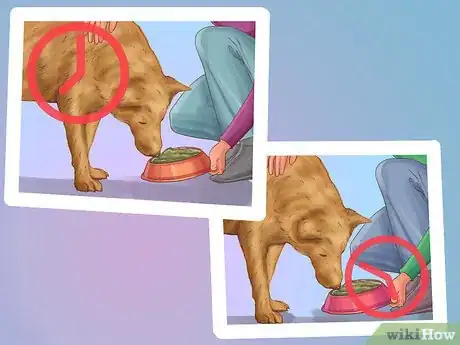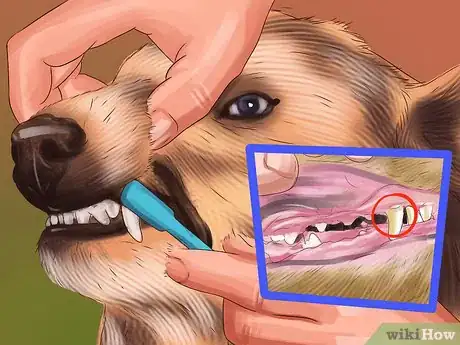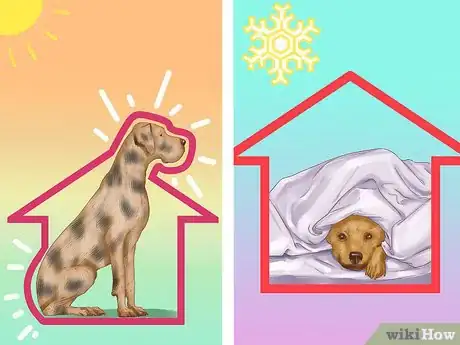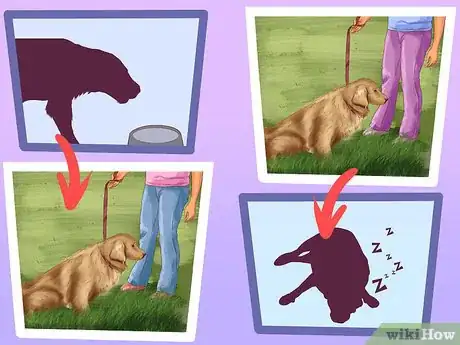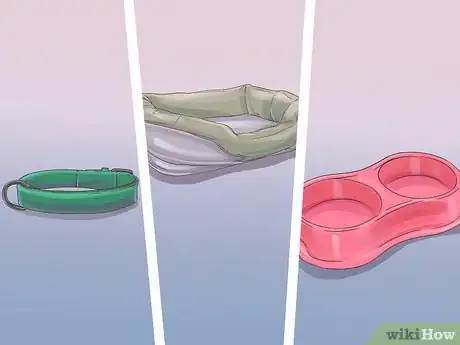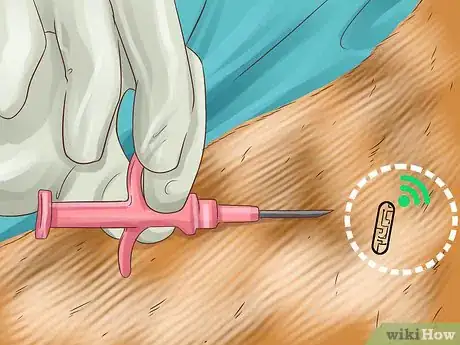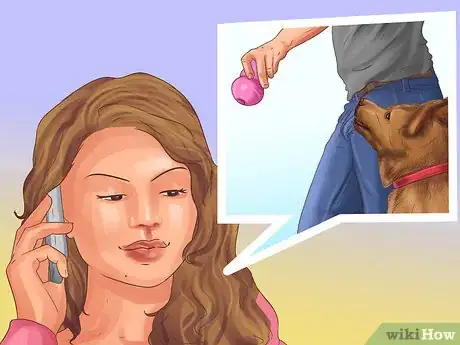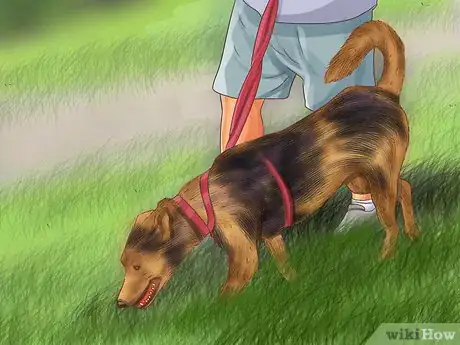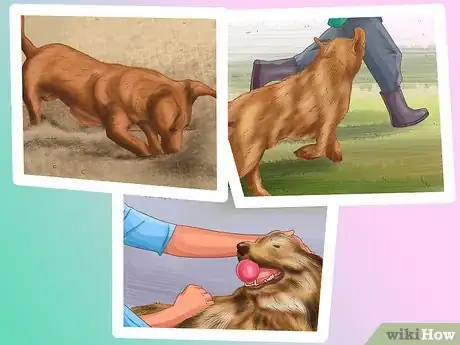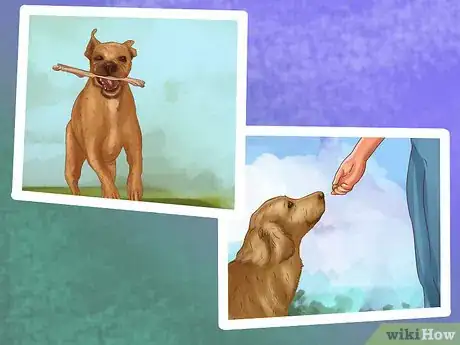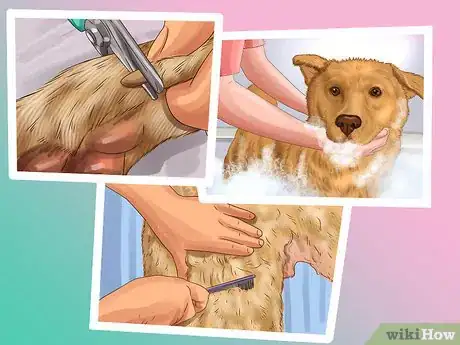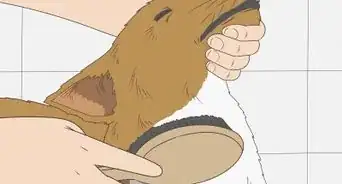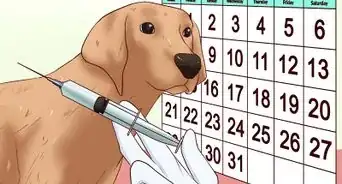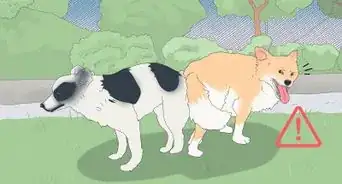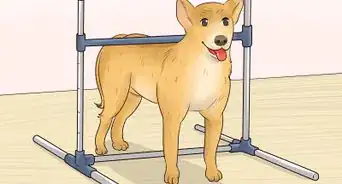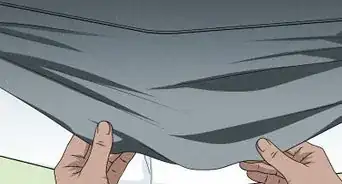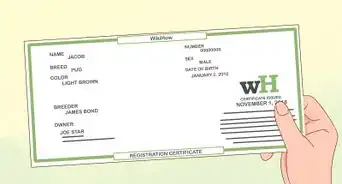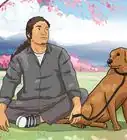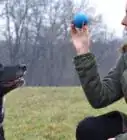This article was co-authored by Brian Bourquin, DVM. Brian Bourquin, better known as “Dr. B” to his clients, is a Veterinarian and the Owner of Boston Veterinary Clinic, a pet health care and veterinary clinic with three locations, South End/Bay Village, the Seaport, and Brookline, Massachusetts. Boston Veterinary Clinic specializes in primary veterinary care, including wellness and preventative care, sick and emergency care, soft-tissue surgery, dentistry. The clinic also provides specialty services in behavior, nutrition, and alternative pain management therapies using acupuncture, and therapeutic laser treatments. Boston Veterinary Clinic is an AAHA (American Animal Hospital Association) accredited hospital and Boston’s first Fear Free Certified Clinic. Brian has over 19 years of veterinary experience and earned his Doctor of Veterinary Medicine from Cornell University.
There are 20 references cited in this article, which can be found at the bottom of the page.
wikiHow marks an article as reader-approved once it receives enough positive feedback. In this case, several readers have written to tell us that this article was helpful to them, earning it our reader-approved status.
This article has been viewed 92,262 times.
When canines are well cared for, they can be loyal companions and beloved additions to families. Make the most of that one-of-a-kind relationship by knowing and doing what’s best for your pet. Being a responsible dog owner means keeping your dog happy, healthy, and safe by taking care of their basic dietary, medical, physical, and psychological needs. It also means monitoring your dog’s behavior and environmental impact in public spaces so that you and your pooch are good members of your community.
Steps
Keeping Your Dog Healthy
-
1Provide your dog with healthy food. Get recommendations from your vet or breeder as to which foods work best for your dog’s breed. The type and amount will vary according to your pet’s age, weight, and activity level, so be sure to consult the packaging for the correct serving sizes.[1]
- A dog’s digestion will be healthiest if you give them a consistent diet. If you do change your dog’s food, introduce the new kind gradually by mixing it in with the old at first.
- Keep in mind that how much you feed your dog is almost as important as what you feed them. Overfeeding can lead to obesity, which increases the risk of heart disease, diabetes, and arthritis.
- Since you want to feed your dog a set amount, it’s best to control their feeding times rather than letting them graze throughout the day. Establish meal times once or twice a day to give your dog a sense of routine.
- Monitor your dog’s treats. It’s always wonderful to reward your canine companions with treats, but be sure that you’re adjusting their normal food intake accordingly. If you feed your dog a bone, reduce the amount of kibble they’ll get for dinner.
-
2Make sure your dog always has access to water. Hydration is critical for your dog’s nutrition, digestion, and joint health. It’s also critical for the regulation of their body temperature. Your dog should always have a dish of fresh, clean water available, even at night.[2]
- If you go on car trips or outings, take water with you for your dog.
- Be sure to clean your dog’s food bowl and water dish regularly to prevent mold, dirt, and bacteria from building up.
Advertisement -
3Clean your dog’s teeth. Regularly brush your dog’s teeth and give them canine dental products, like hard biscuits and dental chews to improve their oral hygiene. Toys that allow them to chew, like rope or nylon bones, will also help keep their teeth clean and gums healthy.[3]
- Brush your dog’s teeth daily. This will prevent bad breath, tartar buildup, and bacterial infections. You can lift their lips to expose their teeth and brush them as would your own.
- To be the most effective, use an angled brush that’s specially designed for dogs. Always stick to toothpaste made for canines since the fluoride found in most human toothpastes is poisonous to dogs.
-
4Keep your dog at a healthy weight. It’s your job to monitor your pet’s food intake and feed them an appropriate amount for their size and ideal weight. While it may seem cruel to deny your dog the food that they’re begging for, letting your dog get obese is more cruel since it compromises their health and well-being.[4]
- If your dog is overweight, ask your vet to recommend a diet to help get them get back to an appropriate weight.
-
5Avoid giving your dog “people food” or medicine. Canines have very different nutritional needs than humans, so stick to feeding them dog food to ensure they’re getting a healthy and well-balanced diet. They also have different medical needs, so never assume that the remedies that work for us will work for them.[5]
- Be aware that many of our common food items are poisonous or even lethal to dogs, like raisins, grapes, mushrooms, onions, macadamia nuts, caffeine, chocolate (especially dark chocolate and baking chocolate), alcoholic beverages, dairy products such as milk, and citrus fruits such as oranges.[6]
- Only give your dog medicines that have been explicitly prescribed or approved by a vet. Many human drugs—over-the-counter or prescription—can kill your dog. For instance, aspirin may be given to a dog if your vet tells you it is alright and tells you the proper dosage. But acetaminophen and ibuprofen are highly poisonous for your pooch.
- Have a canine first aid kit on hand to address your dog’s medical needs. You can either buy one or put one together yourself. Make sure it includes basic supplies like a pet first-aid book, self-cling bandages, gauze pads, an antibacterial ointment or antiseptic wipes, disposable gloves, scissors, and tweezers.
-
6Register your dog with a veterinary clinic. Having an established veterinarian-owner-patient relationship with regular check-ups will help ensure that your dog is as healthy as possible and up-to-date with their vaccinations and parasite control.[7]
- When searching for a vet, be sure to choose one that is nearby to where you live and has good online reviews.
- Go to your vet regularly to minimize your dog’s risk of contracting and spreading dangerous diseases (like rabies or kennel cough) or parasites (like fleas and heartworm). Your vet will keep records to remind you when preventative treatments need to be administered.
- How often you should visit the vet will depend on the health and age of your dog. Puppies will need several appointments in their first year, but a normal, healthy adult dog can generally get by with an annual check-up. Senior dogs who are pushing ten years of age should probably go in at least twice a year.[8]
- Your vet can also help you decide when it’s time to let go. When your pet is stuck in a cycle of incurable suffering due to sickness or old age, the best thing you can do for them is to seek your vet’s help to end your pet's life humanely.[9]
-
7Neuter or spay your dog. Responsible dog owners will control their pet’s reproduction. Neuter or spay your dog as soon as your vet recommends doing so to prevent unwanted litters adding to the numbers in shelters as well as adolescent behavior problems that arise from sex hormones.[10]
- Alternative options are available, too, such as Vasectomy, Neutering, Tubal Ligation and Ovary-Sparing Spay (OSS). While harder to come by, they come with less long term health risks than spaying and neutering. Spaying and neutering comes with many associated health risks such as different types of cancers, orthopedic disorders and cardiac hemangiosarcoma.[11]
- The recovery time from the procedure should be relatively short. You'll just need to keep your dog relaxed and prevent them from licking their wound while they heal.[12]
Creating a Safe Environment
-
1Create a space suited to your dog. Dogs need appropriate shelter. At minimum, that means space to move around, climate control, and clean bedding.[13]
- Start by picking a dog that’s suited to the space you have. For instance, it’s not a good idea to get an active, territorial breed, like a German Shepard, if you live in a studio apartment. Don’t get a high-energy dog like a Border Collie if you don’t have a yard or nearby field where it can run around.
- Keep your dog warm in cold weather and cool in hot weather. Because of their fur and limited perspiration, dogs are easily affected by the heat. Never leave them in a car or place without shade. If it feels too cold for you to be outside, it's too cold for your dog to be outside as well.[14]
- Give your dog a designated place to sleep, whether it be a blanket, dog bed, or crate. If you choose to use a crate, be sure that it’s just big enough for your dog to stand up, sit, lie down, and turn around in.[15]
- When you first bring a new puppy home, it is especially important to have a specific area available only for your puppy. If there are other pets in the home, such as a cat, it is crucial to keep them separated for at least one to two weeks. During that time, they will adjust to each other by scent and will be less likely to provoke each other later.[16]
-
2Make your home safe. “Dog-proof” your house before your pet arrives. That means moving anything that’s valuable and/or breakable out of their reach, blocking access to any area you want to be dog-free, and securely storing any potentially toxic substances.[17]
- Keep garbage cans either out-of-reach (in a low cabinet or in a closed pantry), or make them impossible to get into (using a can with a closed lid). Dogs are often attracted to eating garbage. If you don’t deny them access to it, it’ll create a mess for you to clean up and health problems for them.
- Keep cleaning agents and other poisonous household substances, like antifreeze, out-of-reach.
-
3Let your dog out regularly. Grown-up dogs need to urinate at least every 8 to 10 hours; puppies every few hours. Besides taking your pet on walks, get in the habit of letting them out first thing in the morning, directly before bed, and after mealtimes. Doing so will keep them healthy and your floors safe from accidents.
- Make regular stops if you take your dog on a long road trip, so that he can get out for some exercise and have a drink of water. Never leave your dog unattended in the car!
-
4Make your yard secure. It’s essential to let your dog out, so be sure that the outside is safe for their sake and contained for the sake of your neighbors. Outdoor areas should have a controlled border, established by physical or invisible fencing. Keep dangerous tools (like axes) and substances (like fertilizer) in locked storage.[18]
- Check for holes in the fences or gates, especially if you have a small dog. If you have a puppy, you might want to put wire over gates with gaps in them as very small dogs may be able to fit through the bars.
- Some plants, like poinsettias or holly bushes, are poisonous to dogs. Do an online search for which species are toxic to canines, and then keep them out of reach or remove them to keep your dog safe.
-
5Get the proper supplies. At the very least, you’ll need a food dish, water bowl, collar and/or harness, leash, toys, and bedding. Many people also get a carrier case and crate. Local pet shops can help you pick the most appropriate supplies for your breed of dog.[19]
Taking Responsibility for Your Dog
-
1Tag and microchip your dog. These identification services are available through most vets and are essential to your dog’s safety. If you ever lose them, local authorities will be easily able to track you down if your information is up-to-date in the associated databases.
-
2Monitor your dog’s behavior. You are responsible for ensuring that your dog doesn’t have a negative impact on other people or animals.[20]
- Besides being sure that your dog is under control and supervised at all times when in public, responsible dog owners will get to know their pet’s patterns of behavior so that they can anticipate any issues. For instance, if you notice that your dog growls at strollers, give them a wide berth whenever possible until your dog grows more comfortable with them.
- It’s always the best policy to avoid putting your dog in situations that you know will make them uncomfortable. For example, if your dog is suspicious of or aggressive towards other dogs, it’s not a good idea to let them loose in a crowded dog park because that is not setting them up to behave well.
-
3Socialize your dog. Gradually introduce your dog to new people and environments. Exposing them to a variety of people and places will help them be more comfortable with the world around them.[21]
- Socialization is a slow process, so don’t ask too much of your dog all at once. For instance, if you’re dog has not been in crowds before, it’s not a good idea to take them to an outdoor carnival. You want them to continuously learn more about the world, but you don’t want to overwhelm them.
- When your dog remains calm with new people and settings, reward their good behavior with praise and/or treats.
-
4Train your dog. Obedience training and socialization classes can help ensure that your dog will become a well-mannered family and community member. Training will strengthen your bond with your pet, prevent or correct unwanted behaviors, and create a well-balanced, happy pooch.[22]
- At the very least, every dog should know basic commands, including "sit," "stay," "lie down," "come," and "heel." You might see variations on these command phrases, but the behaviors that they need to learn are the same: responding to you immediately, exercising self-control, staying in a given position, coming at your request, and walking well on a leash.[23]
- Ask your vet, local animal shelter, breeder, or fellow dog owners for trainer recommendations.
- Positive reinforcement, like rewarding your dog with treats or praise when it does something right, is the most effective training method.[24]
- Contract a trainer via phone or visit their website to verify their qualifications. Make sure that the trainer you pick has significant experience, can offer good references, and uses humane methods of “positive reinforcement.” Never go to a trainer whose methods involve physical restraint or violence.
-
5Pick up after your dog. Make sure that your canine is leaving no trace on the environment. Always dispose of your dog's waste in the proper manner and immediately address other damage they might cause, for instance, by filling in any holes they may dig.[25]
- Use a bag to pick up your dog’s feces and dispose of it right away in an authorized trash receptacle. Consider using biodegradable bags to minimize your environmental impact.
- Besides being considerate to your neighbors, cleaning up waste helps prevent the spread of disease.
-
6Keep your dog leashed in public at all times. This will prevent your dog from running away, chasing animals, or jumping on other dogs or people.[26]
- Oftentimes, local law insists that you keep your dog on a leash, so you risk fines if you don’t observe it. Be sure you’re familiar with the dog-related regulations in your area.
- If you’d like to let your dog loose, find an off-lead dog park where they can run free.
Ensuring Your Dog’s Happiness
-
1Be a devoted, consistent friend. Dogs are social creatures, and you’re the center of their universe. They don’t like to be left alone all day. If you’re going to have one as a pet, be sure that you plan on being around more often than not. It’s not fair to your dog to leave them unattended for long periods and may lead to behavioral issues like aggression and anxiety.[27]
- Many pet owners who work during the day get a companion pet for their dogs so that they can keep each other company. You should also consider having a friend or family member visit your pooch, taking them to doggy daycare, or hiring a dog-walker to get your pet out of the house.
-
2Exercise your dog. Your dog needs daily exercise for the sake of their health and well-being. Play with them, and take them for at least one, but preferably two, walks a day to ensure they’re getting enough physical and mental stimulation.[28]
- Without proper exercise, your dog will become bored and many behavior problems may arise (like chewing, excessive barking, jumping, and hyperactivity).
- Play with your dog. Canines have instincts to chew, fetch, chase, hunt, spar, dig, and herd. Help them exercise these instincts in constructive ways through supervised play. For instance, if your dog loves to hunt things, get them a toy that they can safely chase after, like a wooly chew toy at the end of a long rope. That way, your dog can act on their instinct while keeping them away from real animals and at a safe distance from you.[29]
-
3Give your dog mental exercise. Besides working their bodies, you should work your dog’s mind. This means giving them specific tasks (like fetching or finding something) and rewarding them for completing them (with praise and/or treats).[30]
- Most breeds love to have jobs. Giving them work to do will make them more alert and boost their sense of well-being.
-
4Groom your dog. Besides brushing them regularly, you’ll need to occasionally bathe your dog, keep their toe nails clipped, and see that their coat is neatly trimmed. You can consult with an expert to learn how to do these tricky processes yourself or go to a professional groomer to get the job done.[31]
- Comb your dog’s coat at least once a week (or more for long-haired dogs) to control shedding and keep their fur from getting tangled and matted. Brushing can also help clean your dog’s skin and distribute its natural oils. Be sure to use a brush that’s appropriate for your dog’s size and hair length.[32]
- Only bathe your dog when it’s absolutely necessary. Frequent washing can dry out the natural oils in their skins, leaving your pet with constant itches and rashes. When you do, use a mild dog shampoo and warm water. Since dogs have sensitive ears, only wash them from the neck down.
- Keep your dog’s nails short to keep them comfortable and avoid them scratching up your house. Be sure to consult with a groomer or vet about how to clip your dog’s nails before you do it yourself. It’s a tricky process that can easily harm your pet if you do it wrong, so learn the right method from an expert or leave it to a trained professional.[33]
- Some canines are more high-maintenance than others. If you have a breed that requires grooming, like a Poodle or Pekingese, make sure you have a regular appointment set up with a professional groomer.[34]
Expert Q&A
-
QuestionWhat every dog owner should know?
 Brian Bourquin, DVMBrian Bourquin, better known as “Dr. B” to his clients, is a Veterinarian and the Owner of Boston Veterinary Clinic, a pet health care and veterinary clinic with three locations, South End/Bay Village, the Seaport, and Brookline, Massachusetts. Boston Veterinary Clinic specializes in primary veterinary care, including wellness and preventative care, sick and emergency care, soft-tissue surgery, dentistry. The clinic also provides specialty services in behavior, nutrition, and alternative pain management therapies using acupuncture, and therapeutic laser treatments. Boston Veterinary Clinic is an AAHA (American Animal Hospital Association) accredited hospital and Boston’s first Fear Free Certified Clinic. Brian has over 19 years of veterinary experience and earned his Doctor of Veterinary Medicine from Cornell University.
Brian Bourquin, DVMBrian Bourquin, better known as “Dr. B” to his clients, is a Veterinarian and the Owner of Boston Veterinary Clinic, a pet health care and veterinary clinic with three locations, South End/Bay Village, the Seaport, and Brookline, Massachusetts. Boston Veterinary Clinic specializes in primary veterinary care, including wellness and preventative care, sick and emergency care, soft-tissue surgery, dentistry. The clinic also provides specialty services in behavior, nutrition, and alternative pain management therapies using acupuncture, and therapeutic laser treatments. Boston Veterinary Clinic is an AAHA (American Animal Hospital Association) accredited hospital and Boston’s first Fear Free Certified Clinic. Brian has over 19 years of veterinary experience and earned his Doctor of Veterinary Medicine from Cornell University.
Veterinarian Pick dog food carefully. As a general rule of thumb, look for a dog food that contains ingredients you recognize and can pronounce so you're not feeding your dog a lot of unknown additives and ingredients.
Pick dog food carefully. As a general rule of thumb, look for a dog food that contains ingredients you recognize and can pronounce so you're not feeding your dog a lot of unknown additives and ingredients. -
QuestionHow do you feed puppies that will become a giant breed?
 Brian Bourquin, DVMBrian Bourquin, better known as “Dr. B” to his clients, is a Veterinarian and the Owner of Boston Veterinary Clinic, a pet health care and veterinary clinic with three locations, South End/Bay Village, the Seaport, and Brookline, Massachusetts. Boston Veterinary Clinic specializes in primary veterinary care, including wellness and preventative care, sick and emergency care, soft-tissue surgery, dentistry. The clinic also provides specialty services in behavior, nutrition, and alternative pain management therapies using acupuncture, and therapeutic laser treatments. Boston Veterinary Clinic is an AAHA (American Animal Hospital Association) accredited hospital and Boston’s first Fear Free Certified Clinic. Brian has over 19 years of veterinary experience and earned his Doctor of Veterinary Medicine from Cornell University.
Brian Bourquin, DVMBrian Bourquin, better known as “Dr. B” to his clients, is a Veterinarian and the Owner of Boston Veterinary Clinic, a pet health care and veterinary clinic with three locations, South End/Bay Village, the Seaport, and Brookline, Massachusetts. Boston Veterinary Clinic specializes in primary veterinary care, including wellness and preventative care, sick and emergency care, soft-tissue surgery, dentistry. The clinic also provides specialty services in behavior, nutrition, and alternative pain management therapies using acupuncture, and therapeutic laser treatments. Boston Veterinary Clinic is an AAHA (American Animal Hospital Association) accredited hospital and Boston’s first Fear Free Certified Clinic. Brian has over 19 years of veterinary experience and earned his Doctor of Veterinary Medicine from Cornell University.
Veterinarian It's important that you get a puppy food that says it's for large or giant breeds so your puppy is getting all of the nutritional requirements it needs. Make sure a healthy, large-breed dog food makes up the majority of your puppy's diet.
It's important that you get a puppy food that says it's for large or giant breeds so your puppy is getting all of the nutritional requirements it needs. Make sure a healthy, large-breed dog food makes up the majority of your puppy's diet.
Warnings
- Having a dog is a huge commitment. Don’t get one unless you are prepared to take good care of them for their entire life.⧼thumbs_response⧽
- Always supervise your dog when it’s around children. If you can't physically keep your dog in line of sight with children, then separate them.⧼thumbs_response⧽
- A dog isn't a person, so don’t treat them like one. They are an entirely different species with their own anatomy, psychology, instincts, and intelligence. Respect them for who and what they are. Learning to do this will take you very far in being able to train, relate to, and understand them. You can't make a dog happy if you can't work with it at its own level.⧼thumbs_response⧽
- Never, ever leave your dog in the car, with or without the windows down.⧼thumbs_response⧽
References
- ↑ http://www.humanesociety.org/animals/dogs/tips/dog_care_essentials.html
- ↑ http://www.petmd.com/dog/nutrition/evr_dg_the_importance_of_water
- ↑ http://www.akc.org/dog-owners/responsible-dog-ownership/#train
- ↑ http://www.akc.org/dog-owners/responsible-dog-ownership/#train
- ↑ http://www.mnn.com/family/pets/questions/why-you-shouldnt-feed-your-dog-people-food
- ↑ https://www.aspca.org/pet-care/animal-poison-control/people-foods-avoid-feeding-your-pets
- ↑ https://www.avma.org/KB/Policies/Pages/Guidelines-for-Responsible-Pet-Ownership.aspx
- ↑ http://pets.webmd.com/features/your-pet-veterinarian
- ↑ http://www.akc.org/dog-owners/responsible-dog-ownership/#train
- ↑ http://www.humanesociety.org/animals/dogs/tips/dog_care_essentials.html
- ↑ http://www.naiaonline.org/pdfs/LongTermHealthEffectsOfSpayNeuterInDogs.pdf
- ↑ Brian Bourquin, DVM. Veterinarian. Expert Interview. 20 December 2019.
- ↑ http://www.aspca.org/pet-care/dog-care/general-dog-care
- ↑ Brian Bourquin, DVM. Veterinarian. Expert Interview. 20 December 2019.
- ↑ http://thehousebreakingbible.com/wp/training-crate-choices/
- ↑ https://www.bluecross.org.uk/pet-advice/introducing-dogs-and-cats
- ↑ http://www.akc.org/dog-owners/responsible-dog-ownership/#train
- ↑ http://www.akc.org/dog-owners/responsible-dog-ownership/#train
- ↑ http://www.aspca.org/pet-care/dog-care/general-dog-care
- ↑ https://www.avma.org/KB/Policies/Pages/Guidelines-for-Responsible-Pet-Ownership.aspx
- ↑ http://www.akc.org/dog-owners/responsible-dog-ownership/#train
- ↑ http://www.humanesociety.org/animals/dogs/tips/choosing_dog_trainer.html?credit=web_id83183814
- ↑ http://dogtime.com/lifestyle/dog-activities/82-basic-commands-obedience
- ↑ Brian Bourquin, DVM. Veterinarian. Expert Interview. 20 December 2019.
- ↑ http://www.drsfostersmith.com/pic/article.cfm?aid=525
- ↑ http://www.humanesociety.org/animals/dogs/tips/dog_care_essentials.html
- ↑ http://www.caninemind.co.uk/dogsneeds.html
- ↑ http://pets.webmd.com/dogs/guide/exercise-dogs
- ↑ http://www.aspca.org/pet-care/dog-care/general-dog-care
- ↑ http://www.akc.org/dog-owners/responsible-dog-ownership/#train
- ↑ http://www.aspca.org/pet-care/dog-care/dog-grooming-tips
- ↑ http://www.aspca.org/pet-care/dog-care/dog-grooming-tips
- ↑ https://www.vetmed.wsu.edu/outreach/Pet-Health-Topics/categories/procedures/dogs/clipping-your-dog's-claws
- ↑ http://caninebreeds.bulldoginformation.com/grooming-intensive-dog-breeds.html
About This Article
If you want to be a responsible dog owner, walk your dog twice daily so it gets the physical and mental stimulation it needs. You should also make sure your dog always has access to clean drinking water, and that you're feeding it a nutritious, controlled, and regular diet to keep its digestion healthy. Don't forget to socialize your dog, as well, so it becomes more comfortable with the world around it. To do so, introduce your dog to new places, people, and animals slowly over time, so it doesn't get overwhelmed. For more advice from our Veterinarian co-author, like how to train your dog, read on!
